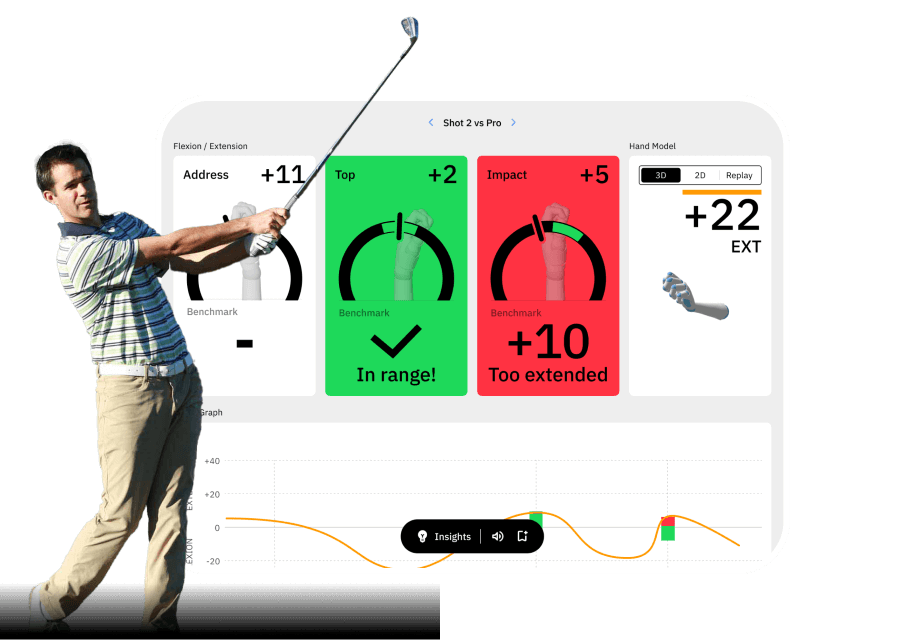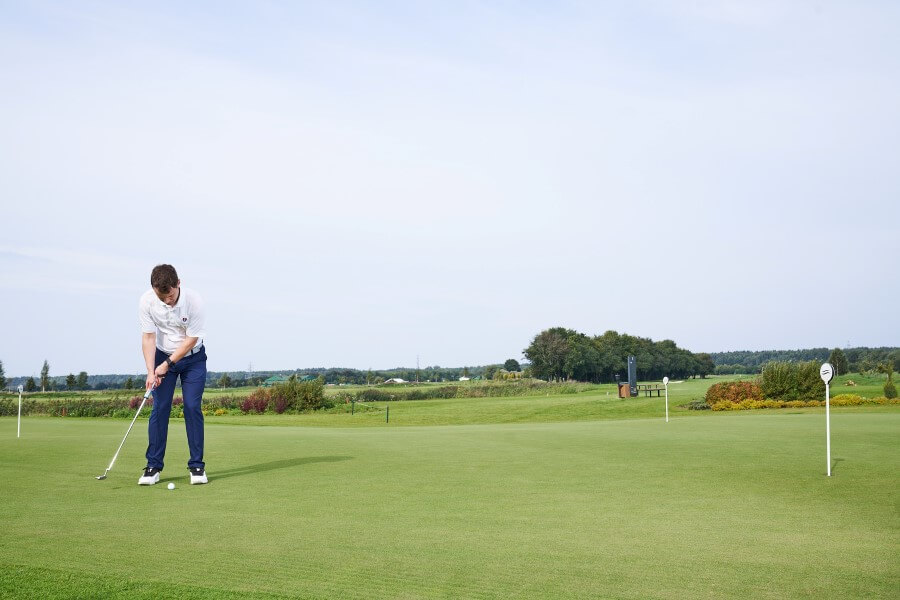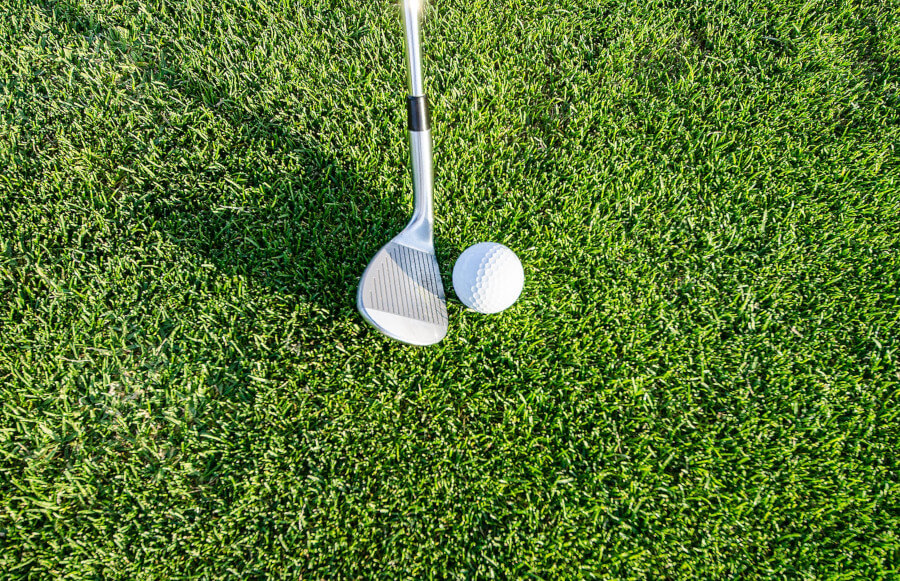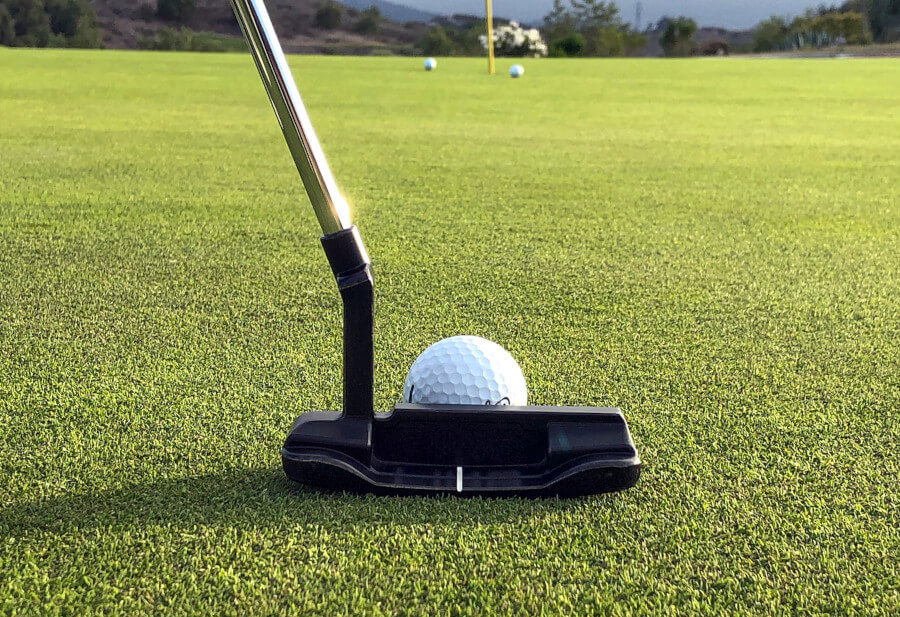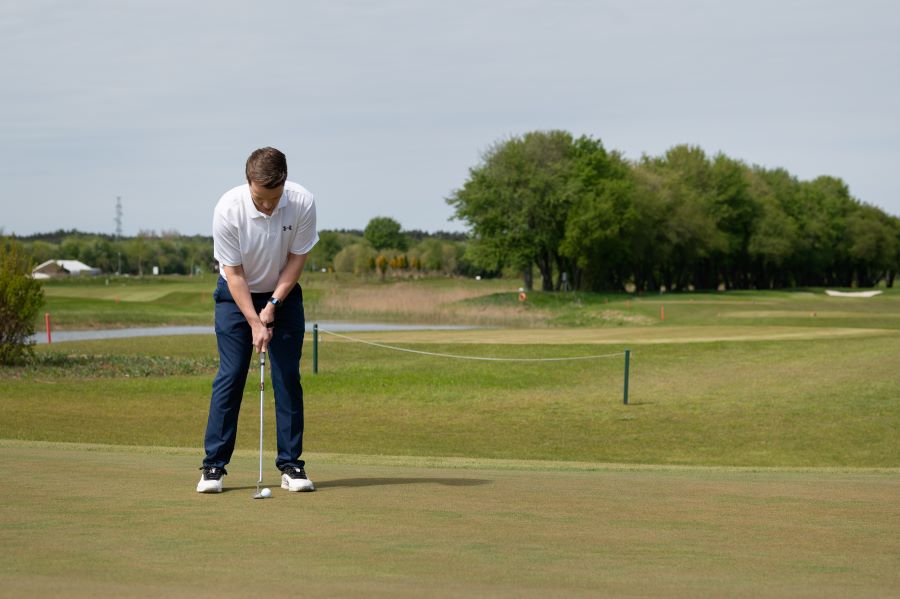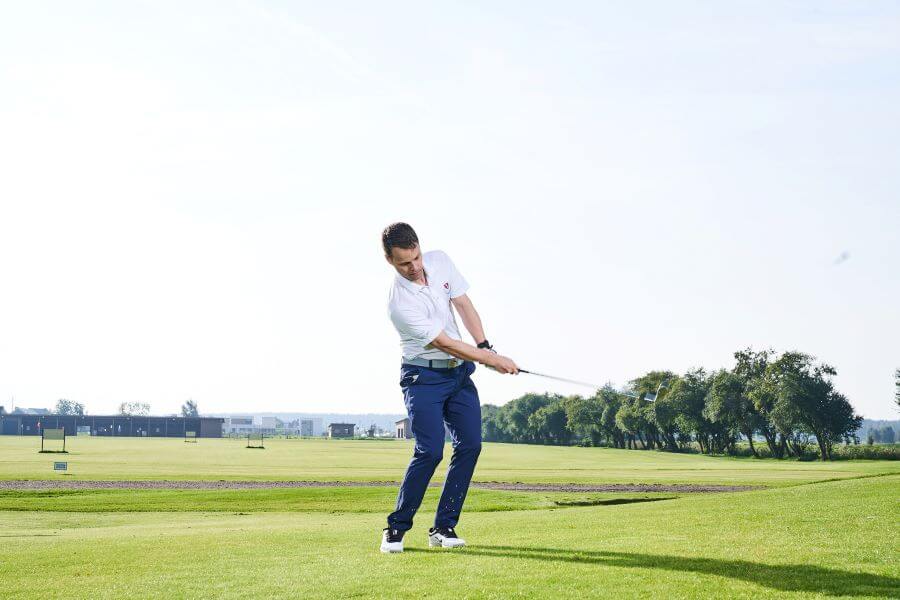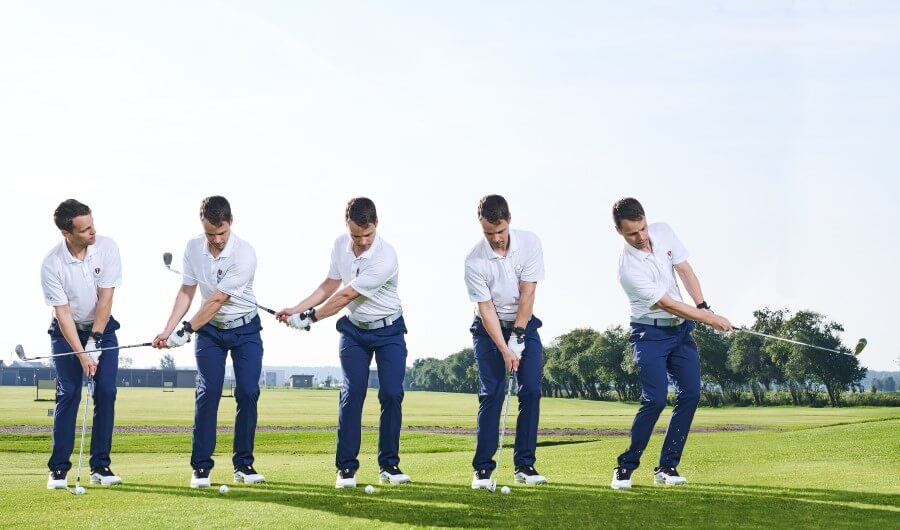15 Best Golf Chipping Tips to Consistently Get Up and Down
A consistent chipping game is vital to your success on the golf course.
Amateurs are often left scrambling to get up and down from the side of the green, and a weak short game leads to dropped shots.
In this post, I reveal my 15 best golf chipping tips to add consistency to your wedge game.
By the end of this post, you’ll know how to produce forward shaft lean, create wrist flexion on the backswing, and induce softer hands. In addition, I’ll give you some of the professional golfer data we collected at HackMotion to see how it’s really done!
Tips for Better Chipping in Golf (Too Long, Didn’t Read)
If you don’t have time to read through our chipping tips right now, here are the key things you must remember.
- Your sternum ahead of the ball pushes more weight onto your front foot; this can help with creating a descending angle of attack and a cleaner turf interaction.
- Forward shaft lean boosts compression and gets the ball airborne.
- Soft hands increase feel, feedback, and control.
- Wrist flexion on the backswing positions your club to catch the ball at the low point; a little extension on the way through can give it that extra height, spin, and zip we need.
- Open the clubface to achieve a smoother glide across the turf, and use the bounce on your wedges.
- Rotation of the body can be used to get the club on the right path; chipping is not just hands, wrists, and arms.
- Brush the turf as part of your pre-shot routine to promote striking the ball cleanly with no divot.
- Be smart about club fitting and wedges; the difference in playability from one wedge to the next is quite significant.
Contents
- The 15 Tips for Better Chipping in Golf
- 1. Sternum Ahead of the Ball
- 2. Ball Position
- 3. Feet Closer Together
- 4. Soft Hands
- 5. Open the Clubface
- 6. Wrist Flexion on the Backswing
- 7. Add a Little Extension Through Impact
- 8. Tilt Your Upper Body Towards the Target
- 9. Straight Back, Straight Forward
- 10. Pick a Target 1/3 of the Way to the Target
- 11. Distance Control Training
- 12. Master the Rough and Tight Lies (Be Versatile)
- 13. Brush the Turf
- 14. Don’t Forget Rotation
- 15. Practice Weekly
- What We Can Learn From the Pros
- Final Thoughts
The 15 Tips for Better Chipping in Golf
1. Sternum Ahead of the Ball
Setup for a chip shot with your sternum or the buttons on your shirt ahead of the golf ball. Place approximately 55% of your weight on your front foot to reach this position.
The clip below from golf coach Chris Ryan highlights how you achieve this.
I find this position sets me up to take the club straight up on the backswing and down to encourage a clean strike.
In addition, shifting weight forward enables me to get my shoulder as close to level as possible to optimize rotation on the downswing. When amateurs attempt to replicate this position, they often produce forward shaft lean but fail to shift weight to the lead leg. Get that weight forward and experiment with this around the greens to find just the right amount for your game.
2. Ball Position
So many golfers have this concept in their mind that playing a chip shot requires hitting the golf ball off the back foot. This just isn’t true.
When the ball is too far back, there are times when you can’t square the clubface and it restricts your rotation back behind the ball. The solution is to place the golf ball between the center of your stance and the inside of your back foot.
Your stance should be narrow and the ball slightly back of center, but certainly not off the back foot. Your adjusted ball position increases your chances of striking the ball cleanly at the low point of your swing for greater friction (a good thing in chipping), spin, and control.
3. Feet Closer Together
How do you expect your brain to know it’s time to hit a short shot if you set up to hit a big one? This concept always makes the most sense to me and helps me remember to NARROW that stance for a chip.
The further my feet are apart, the more it locks my body and forces my upper body to do all the work.
Not a great thing for chipping. I’ve seen golfers who were very good at chipping stand with their feet almost entirely together. Experiment with different positions, but start with your feet much closer than shoulder width.
4. Soft Hands
The day I learned to chip with soft hands was when I elevated my short game. It enhanced my feel, feedback, control, and comfort all in one motion.
Softening your hands encourages you to generate a controlled pendulum swing with limited assistance from your arms.
The lighter grip pressure teaches you to rely on the momentum from your upper and lower body rotation to guide the clubface to impact.
In addition, softer hands boost my feel and feedback to help me better judge the power of each strike and the distance control. I still grip the club, and I’m in control, but soft hands have helped make a big difference in my success on the course.
5. Open the Clubface
Another great tip from Clay Ballard is to open the clubface at address to increase glide through the turf and forgiveness.
When you open the clubface, the flange on the bottom of the golf club is exposed to the turf and glides swiftly across it to prevent digging into the earth.
The crisp turf interaction minimizes chunking and restricts thinned shots for clean contact and greater control. Next, the open clubface enables you to produce forward shaft lean without excessively strengthening the loft.
In the end, your hands lead, and you use the momentum from your shoulder and hip turn to guide the clubface down to the ball and produce a cleanly struck shot.
For those who are a little more advanced and want to learn the action of the wrists and how this open clubface impacts them, move to the next best golf chipping tip.
6. Wrist Flexion on the Backswing
Wrist action has to happen in the chip shot. Golfers love to tell each other to keep their wrists quiet, but there are specific patterns that professionals have, and we should be following these more closely.
PGA of Canada Teacher of the Year Scott Cowx shows how he achieves wrist flexion on the backswing to position the club on plane and your hands ahead of the ball at contact. Watch how he maintains complete control of the shaft and clubhead at the back of the swing before using his hip turn to propel the golf ball down to impact.
He can catch the ball at the low point of his swing by following this path to produce optimal friction and launch it along a shallow and controlled swing path. Producing wrist flexion on the backswing is also suited to playing bump and run shots, where you need the ball to roll more than it flies.
The HackMotion swing analyzer trains you to deliver precise wrist angles for a flop, chip, pitch, and full shot.
7. Add a Little Extension Through Impact
While we are on the topic of wrists, we should touch on the concept of extension through impact. On most golf shots, you want to eliminate the extension you have through impact.
However, with a chip, feeling that slight bit of flexion in the backswing that rotates to extension on the downswing is quite helpful.
Coach Lockey shows us how not to flip and not take the wrists out of it but instead use them correctly.
8. Tilt Your Upper Body Towards the Target
Tilting your body towards the target is another way to ensure forward shaft lean and promote compression at impact.
Although chips run further than they fly, they still enjoy airtime, and to achieve this, you must compress the golf ball by striking it at the low point of your swing.
Your lead shoulder should sit marginally higher than your trail shoulder at contact as you follow through and launch the ball skywards.
You should always be able to draw an isosceles triangle between your shoulders and grip at impact, pointing to the impact zone.
9. Straight Back, Straight Forward
I find the straight-back, straightforward swing works for shorter shots where it is plausible to induce a putting stroke and gently run the golf ball up to the cup. The aim is to develop a pendulum motion and a ¼ swing and follow through along the same plane.
Do not forget to rotate your hips and shoulders. Otherwise, you risk catching the top of the ball or chunking your chip shot.
In addition, this method does cost you some power, and I advise using a stronger lofted club to make up for it. Besides my sand wedge, I use a pitching wedge, 7-iron, and 2-driving iron for these bump-and-run type shots.
As your swing gets longer you can move away from the straight back and straight forward and take the club a little more upright.
10. Pick a Target 1/3 of the Way to the Target
Besides trying to strike the ball cleanly, you have the issue of green reading to understand, as the slope and green speed impact your shot.
Look at the green between your ball and the hole, and identify how it breaks and its pace. Next, identify the best line to the cup, and follow it back from the target to your ball.
The further away your target is, the harder it becomes to hit the spot. Breaking the line up into stages and hitting checkpoints is easier to attain.
11. Distance Control Training
One area I see mid and high handicappers neglect is their chip shot distance control. There is a tendency for amateurs to practice shots from the side of the green, but they need to remember about longer chip shots and struggle to execute them on the links.
Try hitting 10 to 20 shots from the greenside when practicing your chipping, then moving back to 10, 20, 30, 40, and 50 yards. Get used to the force of each strike from those distances and let your muscle memory replicate that on the golf course.
In addition, I recommend hitting chips from different positions, like behind bunkers, from under trees, and various lies. The ability to strike the ball cleanly and generate the necessary friction from anywhere is a game-changer for your scrambling record.
In addition, take a look at the timing of your golf chip shots while wearing your HackMotion. If you pay close attention to the amount of time it takes to complete the swing, you can ensure you stay consistent. The consistency makes the distance control that much easier.
12. Master the Rough and Tight Lies (Be Versatile)
Each lie requires a different ball position and clubface angle to strike the golf ball cleanly to produce the necessary compression and friction. Understanding how to navigate unusual lies around the green reduces your risk of topping, chunking, overhitting, or leaving your chip short of the target.
Tight lies provide limited glide, and as Phil Mickelson explains, placing the toe down helps eliminate bounce and prompt a clean strike.
Leftie places the ball well back in the stance to strike the ball with only the toe hitting the ground. The challenge with this ball position is that it can cause you to catch the ball thin, sending your ball well past the cup.
Conversely, hitting a chip shot from the rough demands a weaker loft and an open clubface to help you get under the ball and launch it out of the cabbage patch.
I recommend placing the ball back in the stance and using a lofted club to boost compression and speed at contact before the thick grass fizzles the attack out. You should give yourself a better chance of the ball stopping on the green. Use more loft when hitting out of the thicker grass.
13. Brush the Turf
Golf coach Kellie Stenzel explains that brushing the grass and keeping the clubface low to the ground creates compression and launch.
Instead of taking a chunky divot, you want to catch the golf ball cleanly with no turf to boost friction, spin, and control. Generating enhanced friction on chip shots prompts your golf ball to spin higher and check up rapidly. As a result, you can attack the flag on short chip shots and enjoy quick bite.
Coach Ballard suggests a simple drill to help you use the club momentum to carry to the ball and keep low to the ground post impact.
All you need is a handful of sand, roughly an inch high, and place it on the turf where your ball would usually be. Focus on clipping the sand gently, and make as many swings as possible until the sand is dispersed. You should make at least four swings before the sand is flattened.
The more you achieve, the lighter your brush with the turf is. Effectively, this drill teaches you the value of gently brushing the turf and carrying the clubface to strike the golf ball cleanly.
14. Don’t Forget Rotation
For some reason, amateurs feel chip shots do not require hip and shoulder turns, instead leaving the work up to your wrists and arms.
However, a lack of rotation on chip shots increases the challenge of getting your clubface down to the ball at the low point of your swing.
I often find that limited rotation on chip shots causes the clubface to catch the top of the golf ball, or conversely, the wedge digs into the turf.
Other players find that they lift the club slightly with their arms and hit thin shots. The little bit of rotation helps employ the ground forces and keeps you closer to the ground.
15. Practice Weekly
Rounding off our best tips for chipping in golf is my advice to work on each aspect of your chipping.
Dedicate at least 1 to 2 hours weekly to work on short, medium, and long chip shots.
Remember to keep most of your weight on the front foot, induce forward shaft lean, and position the ball toward the back of your stance.
Next, hold the club with soft hands, achieve wrist flexion on the backswing, optimize rotation, and brush the turf on the downswing. Neglecting your training and working on the best chipping drills in practice will boost your consistency, distance control, and accuracy.
What We Can Learn From the Pros
The 15 best golf chipping tips is a comprehensive list that can help any golfer become more effective around the greens. However, where we can provide some unique data and insight is when we look at over 1,000,000 golf swings that we have analyzed and reviewed with HackMotion.
Recently, we did a deep dive into a 30-yard chip with data from professionals. The information and results are worth understanding if you want to improve your chipping.
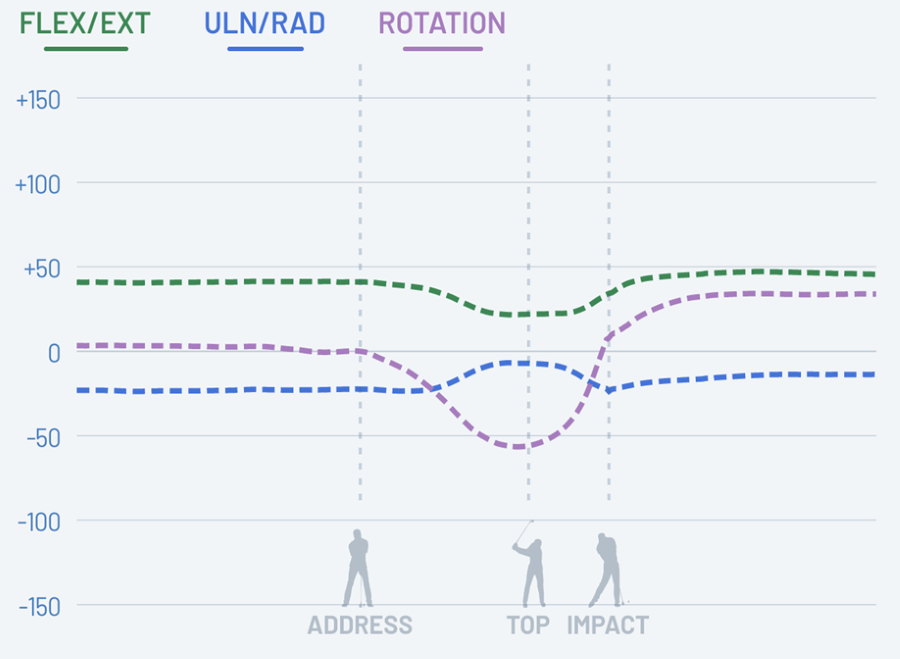
Professionals have less wrist motion in their chip shots than they do in their pitch shots. In the pitch shots, we see more of that move toward flexion in the backswing and into extension through impact. However, this is still happening a bit in the chip shots as well.
Professionals are also rotating when hitting chip shots, but the rotation is minimal compared to what you see in full swing and pitch shots.
The bottom line here is that professional movements are a little less pronounced, the chipping stroke is compact, and you will commonly see just a slight decrease in extension from setup to impact, whereas the full swing, we would want to see a much more significant decrease in extension.
Final Thoughts
Our 15 best golf chipping tips are designed to optimize your setup, backswing, downswing, and follow-through.
Always keep more weight on the front leg and employ forward shaft lean to maximize compression, friction, and spin.
Finally, remember to produce wrist flexion at the top of your backswing to position the club to attack the ball and strike it at the swing’s low point. To improve your wrist angles for better chipping in golf, consider the guidance of the HackMotion Sensor.

